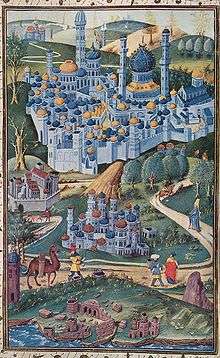Burchard of Mount Sion
Frater Burchardus de Monte Sion or Burchard of Mount Sion in English and Burchard de Mont Sion in French also wrongly called Brocard or Bocard, was a German priest, Dominican friar, pilgrim and author probably from Magdeburg in northern Germany,[1] who travelled to the Middle East at the end of the 13th century and wrote his book which under the title Descriptio Terrae Sanctae or "Description of the Holy Land"[2] is of "extraordinary importance".

Descriptio Terrae Sanctae
It is the most detailed account of the Holy Land to have come down to us from the thirteenth century and is described as having belonged to a class of its own among the many medieval descriptions of the Holy Land.[3] Approximately 100 medieval and early modern manuscripts are known today, some of which include maps and diagrams.[4]
Burchard was in Palestine for 10 years between 1274 and 1284. He then visited Armenia where he wrote about the court of the king of Cilician Armenia, Levon II. Burchard described the country of Cilician Armenia as submitted to Mongol domination,[5] and explains that Mongols were present at the royal Armenian court:
Actually, I spent three weeks with the king of Armenia and Cilicia, who had with him some Tartars. The rest of the attendants were Christians, to the number of about 200. I saw them gather to go to church, listen to the office, bend the knee, and pray with devotion.
— Burchard of Mount Sion, 1282.[6]
Having completed his business there, Burchard sailed to Cyprus, where, he tells us, he was kindly received by Henry II of Jerusalem the last ruling and full titular King of Jerusalem (after the fall of Acre on 28 May 1291, this title became empty) and also ruled as King of Cyprus.
Burchard also wrote a plan for a Crusade, in which he recommended the conquest of Orthodox Serbia and Constantinople as pre-requisites to the accomplishment of a Crusade. His plan is said to have been rather impractical, and to have displayed a dislike of Orthodox Christians, more than of Muslims themselves.[7]
In 1455 Philip the Good Duke of Burgundy ordered his secretary, Jean Mielot, canon of Lille and miniaturist to translate the Descriptio Terrae Sanctae, by Burchard of Mount Sion (1283). The translation was embellished by him with beautiful miniatures of Jerusalem copies of which are held in Bibliothèque nationale de France, Royal Library of Belgium and the Bodleian Library, Oxford.[8] For Burchard's Jerusalem, the map of Jerusalem by Marino Sanudo in his Liber Secretorum Fidelium Crucis.[9] An English translation of the original longer manuscript is provided in Denys Pringle's collection of translated pilgrimage texts part of the Crusade Texts in Translation series published by Ashgate.[10]
Burchard is one of the last pilgrims to travel to the Holy Land and write a full report before the fall of the Latin Kingdom in 1291. According to Jaroslav Folda the account is important not only because of its systematic and yet selective content, but also because of the extent of the actualia included in his discussion.[11]
Notes
- Bartlett, John R. (2013-03-01). "Burchard's Descriptio Terrae Sanctae: The Early Revision". Palestine Exploration Quarterly. 145 (1): 61–71. doi:10.1179/0031032812Z.00000000033. ISSN 0031-0328.
- John, Tolan. "Descriptio Terrae Sanctae". Christian-Muslim Relations 600 - 1500. doi:10.1163/1877-8054_cmri_com_25236.
- Rubin, Jonathan (2014-06-01). "Burchard of Mount Sion's Descriptio Terrae Sanctae : A Newly Discovered Extended Version". Crusades. 13 (1): 173–190.
- Baumgärtner, Ingrid. "Burchard of Mount Sion and the Holy Land," Peregrinations: Journal of Medieval Art and Architecture 4, 1 (2013): 5-41. : "Its various versions, including a short and a long version in Latin and translations into German and French, have been handed down in approximately one hundred medieval and early modern manuscripts and some early printed books of the fifteenth and sixteenth centuries. Burchard’s description, although little studied even today, is considered a key document that influenced the perception of Palestine in both text and image, in travel accounts and maps until far into the sixteenth century. Some of the manuscripts and later prints of Burchard’s text are accompanied by graphical work, including regional maps, diagrams, miniatures, and city plans."
- "He starts by explaining that the country was "submitted to the domination of the Mongols"", in Mutafian, p.66
- Quoted in Mutafian, p.66
- Ruciman, p.440
- "Jean Miélot | Arlima - Archives de littérature du Moyen Âge". www.arlima.net. Retrieved 2017-02-21.
- Marino Sanudo (2011), The Book of the Secrets of the Faithful of the Cross, Ashgate Publishing, Ltd., ISBN 978-0-7546-3059-3
- Denys Pringle (8 April 2016), Pilgrimage to Jerusalem and the Holy Land, 1187–1291, Routledge, pp. 241–320, ISBN 978-1-317-08086-2
- Jaroslav Folda (5 September 2005), Crusader Art in the Holy Land, From the Third Crusade to the Fall of Acre, Cambridge University Press, pp. 392–, ISBN 978-0-521-83583-1
References
- Laurent, J. C. M., ed. (1864). Peregrinatores Medii Aevi Quatuor (in Latin). Leipzig.
- Laurent, J. C. M., ed. (1873). Peregrinatores Medii Aevi Quatuor (in Latin) (2 ed.). Leipzig.
- Catholic Encyclopedia, 1913
- Claude Mutafian, Le Royaume Armenien de Cilicie, CNRS Editions, 1993, 2001, ISBN 2-271-05105-3
- Stephen Runciman, A History of the Crusades, III, Penguin, 1954, ISBN 0-14-013705-X
- Ekkehart Rotter, Windrose statt Landkarte. Die geografische Systematisierung des Heiligen Landes und ihre Visualisierung durch Burchardus de Monte Sion um 1285. In: Deutsches Archiv für Erforschung des Mittelalters 69 (2013), ISBN 978-3-412-22204-8, ISSN 0012-1223, S. 45–106.
- Jonathan Rubin, "Burchard of Mount Sion's Descriptio Terrae Sanctae: A Newly Discovered Extended Version," Crusades 13 (2014), pp. 173–190.
- Jonathan Rubin, "A Missing Link in European Travel Literature: Burchard of Mount Sion's Description of Egypt," Mediterranea: International Journal for the Transfer of Knowledge 3 (2018), pp. 55–90. https://www.uco.es/ucopress/ojs/index.php/mediterranea/article/view/10770/9951
- Palestine Pilgrims' Text Society, London (1896-01-01). The library of the Palestine Pilgrims' Text Society. London Committee of the Palestine Exploration Fund.
- Adrian J. Boas (2001) Jerusalem in the Time of the Crusades: Society, Landscape and Art in the Holy City Under Frankish Rule Routledge, ISBN 978-1-134-58272-3